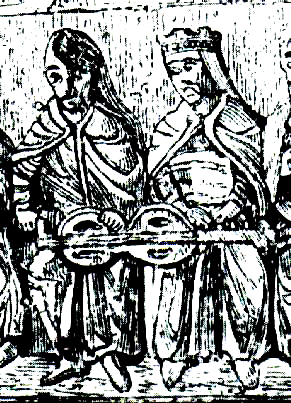Organistrum Orense 200708.jpg on:
[Wikipedia]
[Google]
[Amazon]
The organistrum is an early form of hurdy-gurdy. Generally considered the ancestor of all subsequent hurdy-gurdies, the organistrum differs substantially from later instruments in that it was played by two individuals: one turned the crank while the other pulled the keys upward to change the musical pitch of the melody strings.
 {{commons category, Organistra
The organistrum appears on a bas-relief from the abbey of St Georges de Boscherville (11th century), now preserved in the museum of
{{commons category, Organistra
The organistrum appears on a bas-relief from the abbey of St Georges de Boscherville (11th century), now preserved in the museum of
Origins
The word organistrum is derived from ''organum'' and ''instrumentum''; the former term was applied to the primitiveharmonies
In music, harmony is the process by which individual sounds are joined together or composed into whole units or compositions. Often, the term harmony refers to simultaneously occurring frequencies, pitches ( tones, notes), or chords. However, ...
, consisting of octaves accompanied by fourths or fifths, first practised by Hucbald
Hucbald ( – 20 June 930; also Hucbaldus or Hubaldus) was a Benedictine monk active as a music theorist, poet, composer, teacher, and hagiographer. He was long associated with Saint-Amand Abbey, so is often known as Hucbald of St Amand. Deeply i ...
in the 10th century. This explanation enables us to fix with tolerable certainty the date of the invention of the organistrum, at the end of the 10th or beginning of the 11th century, and also to understand the construction of the instrument. A stringed instrument of the period — such as a guitar fiddle
The Guitar fiddle or Troubadour Fiddle is a modern name bestowed retroactively upon certain precursors of the violin possessing characteristics of both guitar and fiddle. The name guitar fiddle is intended to emphasize the fact that the instrumen ...
, a rotta or oval vielle — being used as model, the proportions were increased for the convenience of holding the instrument and of dividing the performance between two persons. Inside the body was the wheel, having a tire of leather well rosined, and working easily through an aperture in the soundboard. The three strings resting on the wheel and supported besides on a bridge of the same height all sounded at once as the wheel revolved, and in the earliest examples the wooden tangents
In geometry, the tangent line (or simply tangent) to a plane curve at a given point is the straight line that "just touches" the curve at that point. Leibniz defined it as the line through a pair of infinitely close points on the curve. More ...
taking the place of fingers on the frets of the neck acted upon all three strings at once, thus producing the harmony known as organum.
Organistrum in art
 {{commons category, Organistra
The organistrum appears on a bas-relief from the abbey of St Georges de Boscherville (11th century), now preserved in the museum of
{{commons category, Organistra
The organistrum appears on a bas-relief from the abbey of St Georges de Boscherville (11th century), now preserved in the museum of Rouen
Rouen (, ; or ) is a city on the River Seine in northern France. It is the prefecture of the Regions of France, region of Normandy (administrative region), Normandy and the Departments of France, department of Seine-Maritime. Formerly one of ...
, where it is played by a royal lady, her maid turning the crank. It has the place of honour in the centre of the band of musicians representing the twenty-four elders of the Apocalypse
Apocalypse () is a literary genre in which a supernatural being reveals cosmic mysteries or the future to a human intermediary. The means of mediation include dreams, visions and heavenly journeys, and they typically feature symbolic imager ...
in the tympanum of the Gate of Glory of the cathedral of Santiago de Compostela (12th century). There is also a fine example in a miniature of a psalter
A psalter is a volume containing the Book of Psalms, often with other devotional material bound in as well, such as a liturgical calendar and litany of the Saints. Until the emergence of the book of hours in the Late Middle Ages, psalters we ...
of English workmanship (12th century), forming part of the Hunterian collection in Glasgow University; this was shown at the Exhibition of Illuminated MSS. at the Burlington Fine Arts Club in 1908.
References